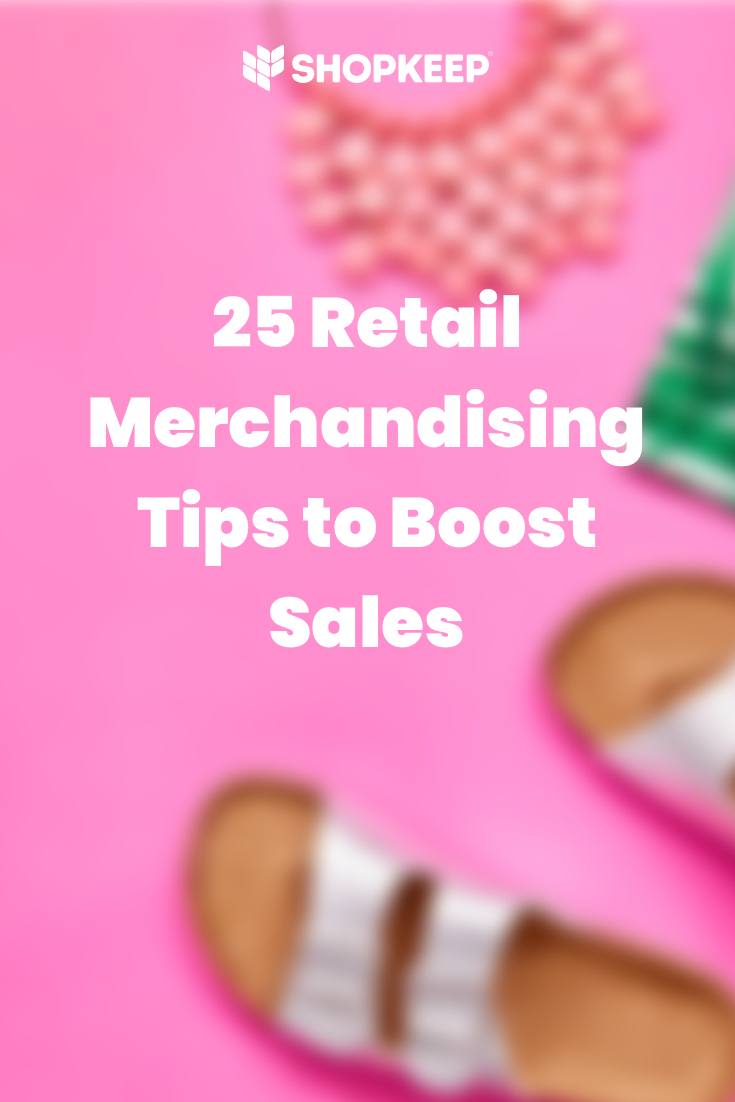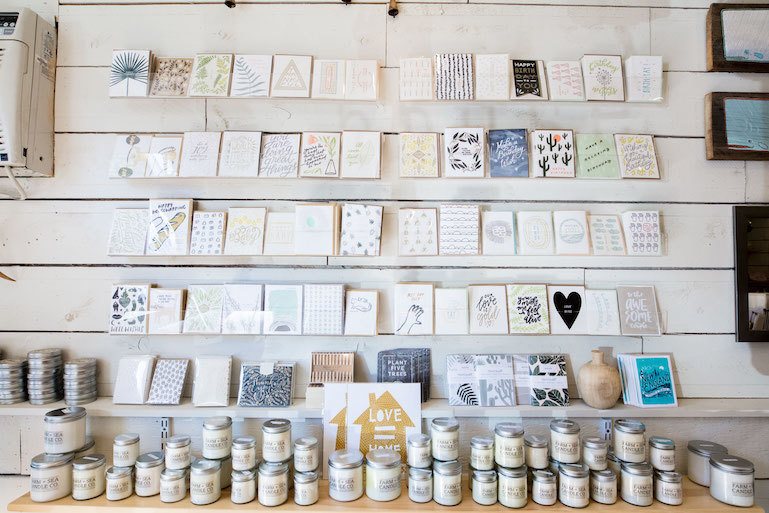
Retail Merchandising Tips and Tricks For Growing Your Business
As a retail store owner, you have a wide variety of tools at your disposal that can help you build a successful business.
A retail merchandising strategy is the most effective; however, it’s also one of the least understood, especially for first-time store owners.
In this post, we’ll answer the question, “What is a merchandising strategy?”, and help you understand the value of retail merchandising by showing you the results it can deliver, while giving you practical advice for applying the concept to your own business.
Without further ado, let’s get started.
What is Retail Merchandising?
Retail merchandising is an umbrella term that encompasses the selection, placement, and display of products within a store. This process can be as specific as selecting the colors of products you want to feature in a merchandising display to as broad as the floorplan of a store.
The term can also be thought of as the experience or set of experiences you create within your retail store to help drive sales revenue. As such, it’s incredibly important. The good news is that most retailers are using some form of retail merchandising without even realizing it. For these retailers, oftentimes, improving their merchandising strategy is as simple as putting a structured and intentional plan behind their actions.
With that being said, to truly succeed with retail merchandising, a strategy isn’t enough. It’s just one side of the coin. To know if your tactics are working or not, you’ll also want to have a system of measurement in place. This is where granular sales and inventory tracking comes into play.
If the thought of looking at charts and performing complex retail math equations is enough to make you want to pull your hair out, don’t worry. Later on, we’ll share some tools that will not only make the process easy but dare we say it, fun.
Retail Merchandising Tips
Since retail merchandising is such a large concept, it can be hard to know where to begin. In this section, we’ll give you some concrete tips that’ll make getting started far easier.
Start with Your Brand and Target Customer
First, you’ll want to start with your brand and the story you’re trying to tell. What does your brand stand for? What message are you trying to get across to your customers? What are your values? Are you a fun and funky brand or are you a little more sophisticated and formal? Answering these questions will help you write your brand story.
This story should be evident in all of the decisions you make about product selection, store layout, display styling, and many more aspects of your business far beyond the scope of retail merchandising. In almost all cases, this story will be built around your company’s value proposition as well as the key qualities that make your business different from competitors.
The same can be said for your target customer. The ideal buyer should be at the center of all retail merchandising decisions you make. You need to understand their ideal customer experience and do your best to create it.
To get started, put yourself in shoes of the type of shopper you want to court. Before you were a business owner, you were a customer. Think of about your ideal shopping experience. What did you expect when you walked into a store? Chances are your expectation aren’t that much different than your customers.
SEE ALSO: 3 Tips For Smarter Brand Management In Small Business
Floor Plan Tips
The floor plan of your store is far more important than you might initially think. A great floor plan not only maximizes your available space without overcrowding things, but it also provides an easy to follow path for shoppers to navigate through your store to increase the likelihood a shopper becomes a customer.
The best way to accomplish this objective is to start at the front of your store and work backward. The rationale is that the front is the first thing a customer will see and it’s where they’ll start to form their initial impressions of your store.
Generally speaking, you’ll want to avoid cluttering the first five to 15 feet of your store’s entrance, depending on store size. This area is called the decompression zone; creating one plays into a shopper’s psychology. Essentially, you’re creating a space that allows a potential customer to transition from the outside world to shopping mode.
Fun fact: In the U.S., shoppers have a natural tendency to move towards the right of the store once walking inside. You can take advantage of this by using this area for engaging retail displays, your newest products, or your top-selling items.
You’ll also want to respect your shopper’s personal space by giving them enough room to shop comfortably. You can create this feeling through your floor plan, and also with your employees’ behavior.
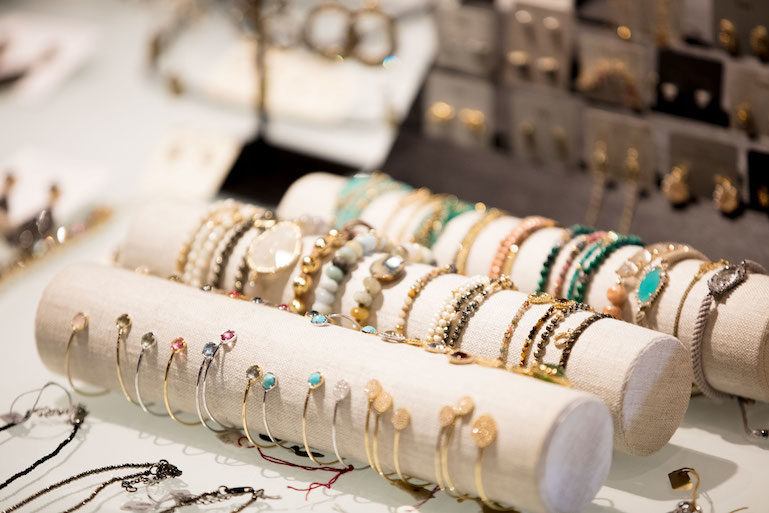
Complementary Products
This is the part of retail merchandising that most merchants do without realizing it. The products you stock should make sense together. This helps give your store a clear identity that’s easy for shoppers to understand and remember.
Mixing product styles or categories too dramatically only serves to confuse shoppers. For example, if you’re a children’s clothing boutique, are you going to sell doggie sweaters? Probably not because it wouldn’t make much sense.
Stick with a theme and be consistent. You can always evolve this theme over time based on customer demand, but you don’t want to stray too far from your base identity.
Organize Products into Logical Groups
Similarly, you’ll want to organize your products into logical groups. This can be as basic as having a boys and girls section, but we recommend going at least one level deeper than that. Continuing with our clothing store example, this would mean having separate sections for sleepwear, playtime-wear, and formalwear.
You can be more creative with your groupings as long as it makes sense to your customers. You often see this approach with sporting goods stores that organize their merchandise by sport, so there’s a hockey section, hunting section, football section, and so on.
Organizing your merchandise in this manner eliminates doubt and questions in the shopper’s mind, which is often a huge barrier to making a purchase.
Fitting Rooms
If you sell clothing or other items that shoppers will want to try on, don’t neglect the role that fittings rooms can play in a purchase decision. In general, you’ll want to follow some basic rules:
- Fitting rooms should be kept clean and organized
- Use mirrors and lighting that are realistic but also flattering
- Ensure the room is climate controlled with AC and heat
- Rooms should be well-staffed without invading a shopper’s privacy
Miscellaneous Tips
Throughout your store, you’ll want to apply these tips to create a pleasing shopping experience:
- Your store should be well lit and clean at all times
- Don’t allow a checkout line to get in the way of people shopping
- Leverage signage to guide shoppers around your store (more on this later)
- Take advantage of impulse buying opportunities especially at the checkout counter
With all of this in mind, let’s take a closer look at visual merchandising, a very important subset of your retail merchandising strategy.
What is Visual Merchandising?
While retail merchandising covers a whole array of tactics you might apply to using products and store layout to drive sales, visual merchandising focuses specifically on how your products are presented and displayed. It includes everything from product displays to signage and lighting. Visual merchandising is an opportunity to get creative without losing sight of the ultimate goal of your efforts: sales growth.
If this is a bit scary to you, don’t worry, we have a bunch of visual merchandising tips to help you get started.
Keep the Buyer In Mind
As with your broader retail merchandising strategy, you’ll want to keep your ideal customer in mind. Try to create displays using lighting other visual elements to create an experience that caters to the customer’s unique personality and values.
Engage all of the Senses
It’s common for a new retail store owner to focus solely on visual elements like displays with some audio added in the form of in-store music. However, that only accounts for two senses, sight, and sound. Humans have five senses that you can leverage to influence and create an unforgettable experience.
An interesting idea along these lines is the use of scent, especially around merchandising displays. This idea isn’t just applicable to the world of beauty or fashion merchandising. If you sell outdoor sporting goods, you could try using woodsy scents like a pine forest or the smell of a campfire to draw a shopper into the experience.
Don’t knock this until you try it. Our sense of smell is powerfully linked to memories and emotion. In fact, studies have shown that 75% of emotions are triggered by smell, which is linked to pleasure, well-being, emotion, and memory. Bake this into your marketing strategies and run with it.
Strategic Product Placement
A shopper’s energy and interest levels fade as they move through your store. To take advantage of this in your in-store merchandising, place your newest, trendiest, or best selling items near the front of the store. This ensures that they see what you want them to when they’re most engaged.
You might put your on-sale or low-cost items towards the back of the store so that there’s a chance a bargain-hunter picks up a full-priced item along the way – or a shopper picks up a bargain item as last minute impulse buy. See, it works both ways. Your customers will help provide the cues.
Keep Things in Rotation
You should rotate your displays every few weeks to ensure that you’re regularly showing fresh product displays. This is especially true if you arrange products or create displays based on a seasonal theme like holidays or back to school.
Display rotation also gives you more freedom to experiment. Come up with a design hypothesis about what might increase sales and test it via your displays. If it doesn’t work, repeat the process with variations. Don’t worry we’ll talk more about how to create displays later in the article.
If You Sell Apparel, Use Mannequins
If you sell apparel and have the budget, use mannequins to help sell merchandise. Sometimes a shopper just can’t imagine how they would look in a particular piece of clothing and they don’t have the time to go into a fitting room. Mannequins help solve this problem and can be the push a shopper needs to make a purchase.
Focus on Upgrades and High-Value Items
In any business, there’s always an opportunity to upsell. With that in mind, focus your visual merchandising efforts and budget on pushing those more expensive products. For example, setup a display of higher-priced dress shirts and suits next to your more affordable options.
SEE ALSO: How to Increase Sales in Retail – The Ultimate Guide
How to Create Effective Retail Displays
As we’ve hinted at, in-store displays are one of the key components of retail merchandising and it’s also a potent sales tool. Their key purpose is to help a customer understand and visualize how a product fits into their home or their life. In this section, we’ll help you achieve this effect, even if you’re a first-time merchandiser.
Tell a Story
You’ll see a significant performance bump if you focus on telling a story. With a piece of marketing content like a blog post or an email, this process is relatively straightforward. But how do you do it with a static retail display?
One of the best ways to do this is to visualize how a customer might use a group of products in their day-to-day life and create a scene that reflects it. IKEA does this better than most. As you walk through one of their showrooms, you’re confronted with a variety of sample bedrooms, livings rooms, and kitchens that show you how you can decorate and furnish your home with IKEA products. In doing so, their visual merchandisers are implanting a story into the shopper’s mind about what their life could be like if they purchased these products.
Keep it Simple
Restraint is one of the great arts of storytelling that also applies to creating a display. Don’t overwhelm customers with a huge variety of products and options. Keep things streamlined and focused on highlighting a few key products that work well together.
This prevents the shopper from overthinking things and keeps them focused on the message you’re trying to communicate. For example, if IKEA is putting together a living room experience, they might display a couch, coffee table, an end table, and maybe a lamp. Even though a TV is a common living room element, they leave it to out to keep shoppers focused on what they sell, furniture.
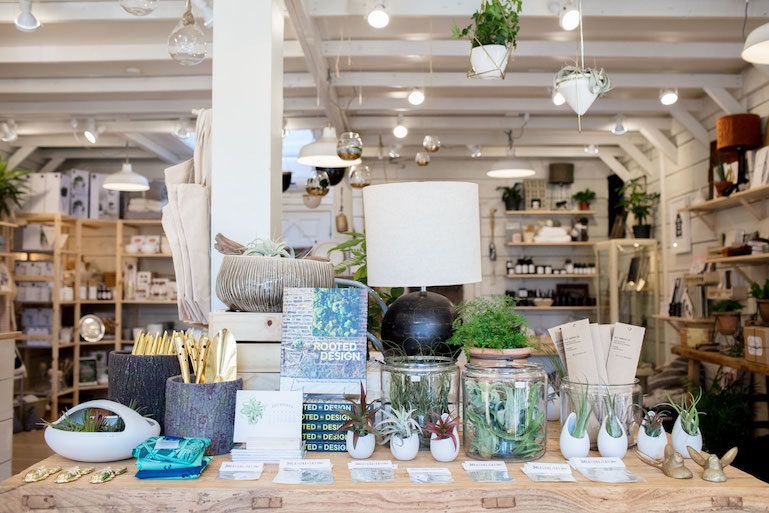
Keep things Consistent
All products within a display should have a consistent theme. If you’re selling apparel and accessories, you don’t need to add kitchen supplies to your display. This does little more than confuse the shopper, presenting a huge barrier to purchasing.
Use Color Theory
This is a little more subtle but also very important, you’ll want to think about the colors featured in the display and the psychological connotations they create. Some refer to this concept as color psychology and it’s a powerful tool used by marketers in everything from brand development to lead generation campaigns. Try to work this idea into your displays to reinforce the message you want to deliver.
Stimulate the Senses
Humans are thinking and feeling creatures. By stimulating the senses, you can increase the level at which shoppers engage with your merchandise. This can be applied in a lot of different ways, so here are a few ideas to get you started:
- Use lighting to enhance the visual quality of your displays
- If you sell particularly soft clothing like a fleece or sweater, put it where customers can touch it
- Use fragrance to draw shoppers in and play on memory
- If you sell food, create a display offering free samples
The key here is to embrace experimentation. If you have an idea or hypothesis, test it out for a few days, keep what works, and ditch the rest.
Think Outside the Store
Your in-store real estate isn’t the only place to use displays. If you have the ability to do so, consider creating window displays or arrange some merchandise on the sidewalk outside your store. This is a powerful way to capture the attention of passersby and draw them into your store. In general, the same rules apply to these types of displays. But you may want to focus more of your energy on creating visually unique displays. The more eye-catching they are, the better your chances of getting someone to stop in their tracks to enter your store.
Change Your Displays Often
You’ll also want to keep your displays rotating on a regular schedule. As fresh products come in, new bestsellers emerge, and seasons change, you’ll want your displays to reflect these trends.
The hallmark of any successful business is a large and engaged base of regular customers. To keep these customers happy and coming back, you’ll need to offer variety in your store. That’s where a well-considered display rotation plan can be the key to steady customer engagement and sales growth.
Reinforcing Your Strategy with In-Store Signage
Often an afterthought, in-store signage can be a great tool for helping shoppers quickly understand the layout of your store., It’s also a great way to let customers know about any promotions that are currently running. However, it’s really easy to overdo it and create signage that causes more confusion than clarification.
To prevent this from happening let’s look at a few quick tips for creating signage that reinforces your overall retail merchandising strategy.
Where to Start?
In our opinion, the best place to get started with signage is by answering the most common questions that customers ask you and your staff. Some of these will be mundane like “where’s the restroom?” or “are you running any sales right now?”, but others could be more unique. For example, if you’re displaying a product demo like “4 ways to tie a necktie” that shoppers can interact with, it might make your life easier to provide some simple instructions for tying each of the knots. This frees up your staff to perform other tasks.
Keep Signs Clear and Consistent
Because signs are supposed to answer questions and communicate important information, you’ll want to ensure that your writing is clear and easy to understand. This prevents follow-up questions and general confusion on the part of the shopper.
On a similar note, it’s recommended that all of your signs maintain a consistent look and color scheme. This keeps things from looking messy or visually confusing.
Readability is Essential
If customers can’t read your signs then they are not doing their job. This means using simple and tasteful fonts that are easy to read at a glance. In many cases, this means avoiding the use of script typefaces and handwritten signs.
It should go without saying, but if shoppers can’t see your signs, then they can’t read them either. This means placing them in locations and at heights that cater to the vast majority of people.
Still Need Help?
If you’re still feeling overwhelmed, don’t worry. There are plenty of ways that you can create an effective retail merchandising strategy without having to do it all yourself.
Hire a Merchandising Manager or Merchandising Associate
Retail merchandising is a well-established career path. If you’re serious about doing it well, and you don’t have the time to do it yourself, consider hiring an experienced professional. These individuals will have years of experience and knowledge that can give you a head start and take the work off of your hands.
As far as hiring advice goes, be sure to review their resume carefully, ask to see their portfolio of work, and always ask for professional references.
Work with a Merchandising Service
There are a variety of organizations that provide merchandising-as-a-service to retailers The benefit to working with one of these companies is that they’re contracted by a variety of retailers across multiple industries. Therefore, they often have a far larger range of experience than any single employee you can hire.
The downside is that you may pay a premium for their services. However, this is really down to the contact you negotiate with the service. They may have a minimum contract value or a minimum number of hours you need to hire them for, or they may be open to ad-hoc work.
Hire an Intern
If you want to hire someone, but don’t have the budget for a full-time hire and you can’t find any skilled part-time employees, consider ‘hiring’ an intern. Many local colleges and universities offer degrees in visual merchandising and students are eager to find internships to gain real-world experience.
However, there are laws governing intern compensation so that’s something you’ll want to look into before proceeding with an internship program. Every university structures their intern program differently so you’ll need to know the details of each college program and make sure that it’s something you can commit to.
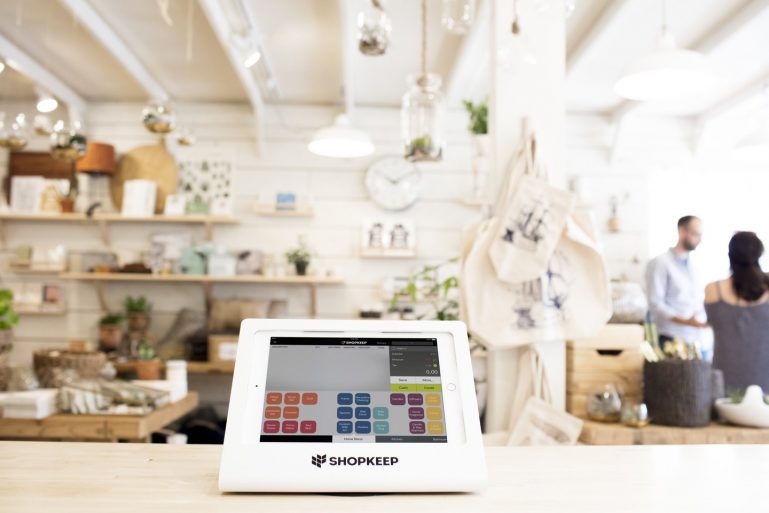
Measurement System
Retail merchandising includes a lot of moving parts, so you’ll want to ensure that you have the right tools in place to measure the effectiveness of your efforts. For most small business retailers, a tablet point of sale (POS) system is the best measurement tool.
These systems are far less expensive than traditional legacy POS and inventory management platforms. But that lower cost doesn’t mean a sacrifice in capability. You’ll still get all of the robust inventory tracking and sales reporting capabilities you need to make informed decisions. With these reports, you’ll be able to see if new displays, shelf stocking techniques, and other tactics are delivering the return that you expect.
All of this is in addition to the other capabilities of a modern tablet POS system. At a high level, this includes the ability to accept all payment types such as cash, credit and debit cards, and even NFC transactions like Apple Pay. Other benefits include unparalleled ease of use, knowledgeable customers support, and integrations with other software tools like QuickBooks for accounting and MailChimp for email marketing.
SEE ALSO: Small Business Basics: What is POS Software?
Summing it All Up
At the end of the day, a retail merchandising strategy is one of the most effective tools a retailer has at their disposal to build a successful business. And while this domain is far-reaching, most retailers will begin to see returns on their strategy simply by applying a few of the tips we’ve provided in this article.
Want to try ShopKeep for yourself?
Just answer a few easy questions.
Need help finding the right point of sale?
Just complete the form. We’ll call you right back to explain how ShopKeep can work for you.
Hit the ground running.Sprinting, in fact!
Read our free, comprehensive guide, Small Business 101, to learn all you need to know about starting a thriving business.

